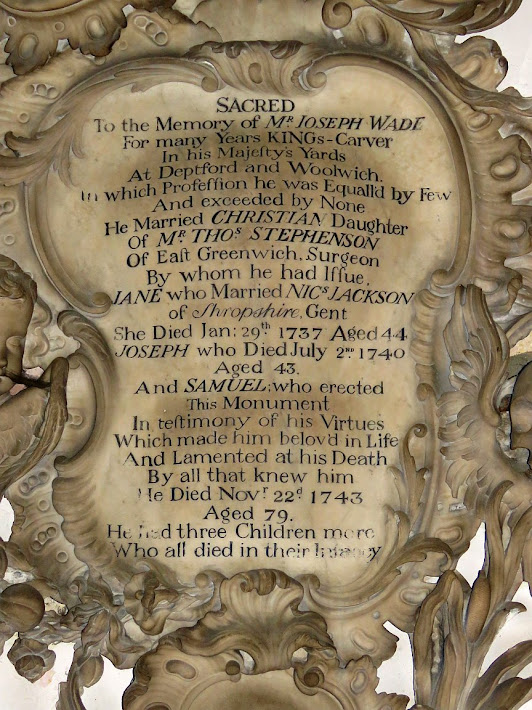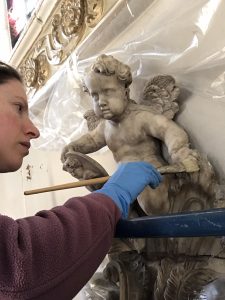Joseph Wade (c.1664 - 1743) Master Ships Carver
Sculptor.
Joseph Wade the master carver, shown in the portrait below in undress, holding a bust of Hercules, as a decorative mason he collaborated with Richard Chichley ( another ships carver) on the continued building and
elaboration at Greenwich Palace.
There is a reference to a Benjamin Wade carver, possible the father of Joseph Wade - Joseph Helby, Carver at Deptford and Woolwich. Asks for protection - Navy Papers, National Archives.
In Figureheads of the Royal Navy by David Pulvertaft 2011 it states that in about 1720 Wade was made Master Carver at the Royal Dockyards in Deptford and Woolwich and was paid hansdomely for the refurbishment of six royal yachts between 1724 and 1742 as well as the carved works on several new build warships.
See also - Ship Decoration, 1630–1780 by Andrew Peters 2013.
____________________
There are numerous references to Joseph Wade in the ADM (Admiralty Royal Navy etc) records at the National Archives Here is a selection:
31 March 1718 Folio 129: Joseph Wade, Master Carver. Asks for protections for the men on the enclosed list, Carvers he employs at Deptford and the Watermen who carry his goods to that yard.
Reference: ADM 106/723/129
Mar 1718, Unsigned. A list of 19
named men employed by Joseph Wade, Master Carver.
Reference: Folio 130: enclosed with folio 129. ADM
106/723/130 National Archives
1 Oct 1718 Folio 354: Robert Jones, Joseph Wade, Richard
Chichly, Carvers. Regarding the payment of their bills.
Reference: ADM
106/717/354 Nat. Archives
14 March 1722, Folio 50: Joseph Wade. Will send a bill for
stone carving.
Reference: ADM
106/752/50 Nat. Archives.
15 April 1724 Folio 235: Joseph Wade. Asks for an order for the
Woolwich Officers to pay him more for his carving work.
Reference: ADM
106/767/235 Nat. Archives
4 May 1724 Folio 191: Woolwich Officers. Concerning the payment for the
carved works done by Joseph Wade. ADM 106/767/191
12 May 1724 Folio 194: Woolwich Officers. Bill for the carved work on
the Kent, Ludlow Castle, Weymouth, Looe and Rose by Joseph Wade.
Reference: ADM
106/767/194
14 April 1727 Apr 14 Folio 81: Joseph Wade. Asks for
protections for 14 named men.
Reference: ADM
106/795/81 Nat Archives
Apr 19 1732 - Joseph Wade, Sr., Joseph Wade, Jr., Richard Chicheley, Master Carvers, Deptford, Woolwich and Chatham. Petition on behalf of William Smith and Widow Reed, Master Carvers of Portsmouth and Plymouth. They are suffering hardship because their bills are 4 years in arrears. In the time of King Charles the Second, Master Carvers had money advanced to them by the Government in proportion to how the work was progressing. Ask for payment.
Ref. ADM 106/843/157 Nat Archives
25 May 1741 - Joseph Wade, Rotherhithe. Encloses an account of
carved work done to a model of a first rate built at Deptford (not now
attached). Request for an order for it to be surveyed and valued
Reference: ADM
106/949/113 Nat. Archives
20 June 1746
Woolwich Officers. A bill for carved work on a model of a
first rate by Joseph Wade.
Reference: ADM
106/1038/185
________________
1719 - 20. Carved work with Richard Chichley (the elder) at St Paul's Church, Deptford.
Between 1726 and 1728 Joseph Wade worked in partnership
with fellow-sculptor Richard Chichley on the ornamentation of the West Middle
Front at Greenwich Palace. This work was very well paid. In 1729 he was paid £101 for his solo
work on the South Pavilion of Queen Anne's Court - a sum including £8 per face
for Corinthian Capitals, £21/107- for forty three modilions and £3 each for two
scrolls, carved to a depth of two feet.
In 1725 he was working in partnership with Thomas Darby for St George in the East Wapping and presented bills for -
7 Cartoozes carved 2ft by 9 by 9 in costing £10 10s
4 Scrolls uner the pulpit carved 4.2 by 1.2 girt £6 8s
7 Leaves carved at head of said scrolls 1.3 by 4ins £2 12s 6d.
9 Brackets at end of steps carved 8 by 5 ins £1 11s 6d.
8 Festoons carved 3.5 by 5 ins Embost £6
8 Faces of capitals carved after the Corinthian order at £7
4 Capitals to pillars carved after the Corinthean order 12 ins diameter at £16
as well as £5 5s for 21 days spent on patterns
Destroyed in the blitz 1941.
Information above from ORATORIAL MACHINES FOR FURNITURE HISTORIANS
by Terry Friedman Furniture History, Vol. 33 (1997), pp. 84-10.
In December 1728 Joseph Wade, King's Carver was paid £40 for having carved twenty shields for the great hall at Fishmongers Hall -
Image from the journal of the Society of Heraldic Craftsmen, no 88, April 2015
Wade was paid £10 15s for two posts? in front of the Chapel porch at the Mercers Hall - I do not have the date; info from The Mercers Hall by Jean Imray pub. 1991.
Records for St Alphage's Church Greenwich at Lambeth Palace record 22 October 1725, a petition by Joseph Wade, carver, for
payment for work left undone by Mr. Jones (f.147).
In 1740 Wade recieved £121 9s 1d for carvings on the Duke of Kingston's new yacht 'Mary'
On 29th of September 1741, in the Deptford Yard letter books, preserved at the Public
Record Office, (ADM/106/3357) it gives an account
of the charges of the not inconsiderable sum of £77 18s 4d for carving for a model of a 1st Rate ship by Mr. Joseph
Wade.
Further research might be able to pin down which ship - this entry would perhaps suggest that there were several of these ship models constructed by Joseph Wade
info above from https://liverpoolnauticalresearchsociety.org/wp-content/uploads/2019/03/Transactions-New-Vol-09-1955-61.pdf
Wade died 22 November 1743 aged 79.
16 June 1746 - Samuel Wade, London. Request for a bill for carved work done by Joseph Wade, his late father.
From the National Archives - Reference: ADM
106/1038/391
1746 June 20 Woolwich Officers. Are enclosing an account of the late
Joseph Wade's carved work of a model of a 1st Rate for use of the Admiralty.
From the National Archives - Reference: ADM 106/1038/184
see - A Biographical Dictionary of British Sculptors 1660 - 1851.. Pub Yale 2009
Portrait of Joseph Wade (c.1664 - 1743) 1720's holding a bust of Hercules
James Parmentier
Oil on canvas
Mid 18th Century
35 3/4 x 27 3/4 inches 91 x 70.5 cm.
James (Jacques) Parmentier was born in Paris and commenced his
career as a pupil of his uncle, Sebastain Bourdon. He was later to work with
Charles Delafosse and collaborated with him on their major commissions for
Montagu House. He painted two altar pieces for Holy Trinity Church in Hull and St Peter's
Church in Leeds. Thomas Howard, the Eighth Duke of Norfolk, commissioned him to work at Worksop Manor where he painted the staircase.
Image Courtesey Philip Mould. see -
http://www.historicalportraits.com/Gallery.asp?Page=Item&ItemID=1074&Desc=Joseph-Wade-|-James-Parmentier
.......................
Mrs Catherine Wade
Parmentier
The images above from
Paul Mellon Centre Photographic Archive
________________
The Rococo Monument to Joseph Wade at St Mary's Rotherhithe, London.
Note the portrait rondel held by the putto.
Anonymous sculptor.
I think it is too florid for Henry Cheere and suggest that is possibly by Charles Stanley
see - http://bathartandarchitecture.blogspot.com/2019/03/maynard-monument-by-charles-stanley.html
http://english18thcenturyportraitsculpture.blogspot.com/2019/02/the-huntington-marble-bust-of-oliver.html
I will post more on Stanley in due course
The inscription suggests that it was erected shortly after the death of Samuel Wade son of Joseph Wade in 1743.
This fabulous monument is perhaps unique in its high Rococo, asymetrical style - a cursory trawl through the the Church Monuments Gazeteer website fails to bring up anything quite like it. Making it very difficult to suggest an author.
The design shows clearly the influence of Henry Copland and Matthias Lock
see http://www.churchmonumentsgazetteer.co.uk/Gazetteer.html
Photographs courtesey the website of Bob Speel
see -
http://www.speel.me.uk/chlondon/rotherhithestmary.htm
_________________
This remarkable monument has recently (2020) been cleaned by Charlotte Okparaeke BA (Hons) Conservation. of the City and Guilds of London Art School.
For Rococo Ornament in England see -
https://www.riha-journal.org/articles/2014/2014-jan-mar/special-issue-art-design-history/puetz-drawing-from-fancy/#__RefHeading__388999_623944600
_______________________________
This is probably not the place to go into the emergence of the Rococo in England and the influence of the earlier French and German engraved sources, but the works of Thomas Johnson, William Delacour Henry Copland and Matthias Lock have obviously influenced the design of the Wade Monument.
William De La Cour
One of the earliesRococo pattern books pulished in England
Catherine Street, Strand, London (1747)
Mr Read's, Grocer, at the Sign of the Ship, Great Russell
Street, Covent Garden (1752)
The Green Door, Winchester Street, New Broad Street (1753)
Biography
Portrait, decorative and scene painter, and ornamentalist.
Presumably French origins; 1740, first documented as a scene painter for London
theatres; published eight books of ornament between 1741 and 1747, engraved by
himself, Vivares or Robert White;1752, calls himself 'portrait painter in oils
and pastels'; 1753, in Dublin; in Edinburgh by 1757 where he was still working
as a scene painter; 1758, working for John Adam as a decorator (see
correspondence in Saltoun papers, NL Scotland); 1760, first director of School
of Design set up by Lord Kames; 1761, executed large wall paintings at Yester;
many portraits in Scottish collections dating from 1758-65; d. Edinburgh 1767.
Info from British Museum website -
https://www.britishmuseum.org/collection/term/BIOG24718
_________________________


Pierre - Edme Babel
1735
___________________
Johan George Hertel (1719 -68
Engraving probably a little late to have influenced the design of the Wade monument
______________
The website of St Mary's, Rotherhithe suggests that the raredos in the church was also carved by Wade
see http://www.stmaryrotherhithe.org/index.php?option=com_content&view=article&id=7&Itemid=9
_______________
Unfortunately I have had to rely on external web sources for the photographs but I hope to visit the church and take my own photographs in due course.
____________________
The Will of Joseph Wade of Rotherhithe
Currently available free from the National Archives
He leaves the majority of his estate the considerable sums of £100 to his grandson and £500 and the residue of his estate to his grand daughter.
https://www.nationalarchives.gov.uk/















%20Mrs%20Wade.jpg)














